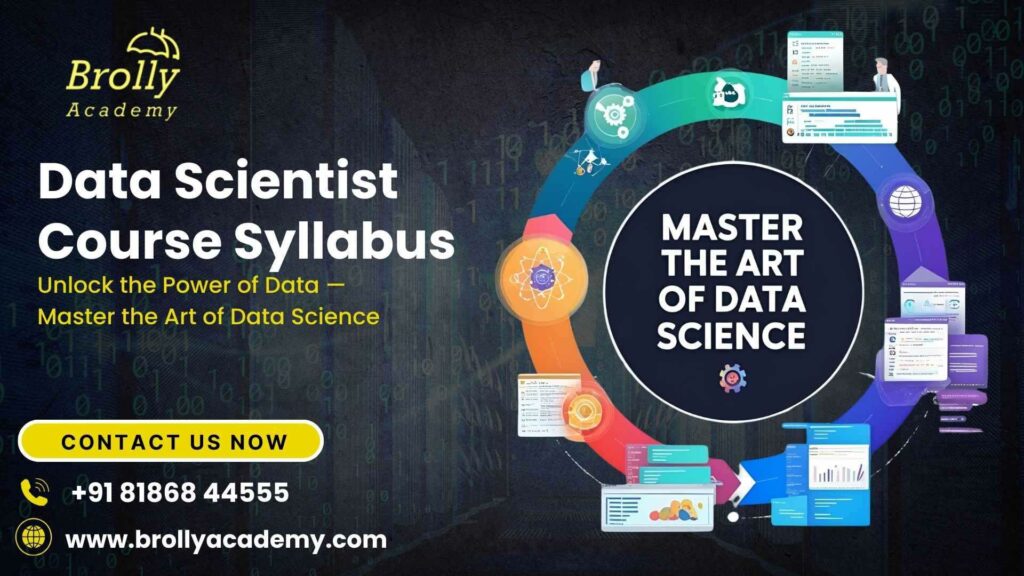Data Scientist Course Syllabus

Looking for the latest Data Scientist Course Syllabus & Subjects in India 2025? Download the PDF now to explore key topics, tools, and career insights. Stay ahead in data science
Data Scientist Course syllabus for beginners
Module 1: Introduction to Data Science
- What is Data Science?
- Evolution & Importance of Data Science
- Applications of Data Science in Real-World Scenarios
- Data Science vs Data Analytics vs
- Machine Learning
- Skills Required to Become a Data Scientist
- Understanding Data Science Workflow
Module 2: Python & R for Data Science
Python Basics
- Introduction to Python
- Python Data Types & Operators
- Conditional Statements & Loops
- Functions & Modules
- File Handling
- Exception Handling
Data Handling with Python
- NumPy: Arrays, Operations, Indexing, Broadcasting
- Pandas: DataFrames, Series, Data Manipulation
- Matplotlib & Seaborn for Data Visualization
Introduction to R (Optional – Based on Course)
- Basics of R Programming
- Data Types & Variables in R
- Data Visualization with ggplot2
Module 3: Mathematics & Statistics for Data Science
Descriptive Statistics
- Measures of Central Tendency (Mean, Median, Mode)
- Measures of Dispersion (Variance, Standard Deviation)
- Skewness & Kurtosis
Inferential Statistics
- Probability Distributions (Normal, Poisson, Binomial)
- Sampling & Sampling Techniques
- Confidence Intervals
- Hypothesis Testing (Z-test, T-test, Chi-square test)
Linear Algebra for Data Science
- Vectors & Matrices
- Eigenvalues & Eigenvectors
- Matrix Factorization
Module 4: Data Preprocessing & Feature Engineering
- Handling Missing Data
- Data Cleaning Techniques
- Encoding Categorical Variables (One-Hot Encoding, Label Encoding)
- Feature Scaling (Normalization, Standardization)
- Feature Selection Techniques (Variance Threshold, Recursive Feature Elimination)
- Dimensionality Reduction (PCA, LDA, t-SNE)
Module 5: Machine Learning - Supervised Learning
Regression Models
- Linear Regression
- Multiple Linear Regression
- Polynomial Regression
- Ridge & Lasso Regression
Classification Models
- Logistic Regression
- Decision Trees
- Random Forest Classifier
- Support Vector Machine (SVM)
- Naïve Bayes
- k-Nearest Neighbors (k-NN)
Module 6: Machine Learning - Unsupervised Learning
- K-Means Clustering
- Hierarchical Clustering
- DBSCAN Clustering
- Principal Component Analysis (PCA)
- Association Rule Learning (Apriori, Eclat)
Module 7: Deep Learning & Neural Networks
- Introduction to Neural Networks
- Activation Functions
- Artificial Neural Networks (ANN)
- Convolutional Neural Networks (CNN)
- Recurrent Neural Networks (RNN)
- Transfer Learning
- Autoencoders
Module 8: Natural Language Processing (NLP)
- Tokenization & Text Cleaning
- Stop Words Removal
- Stemming & Lemmatization
- TF-IDF & Word Embeddings
- Sentiment Analysis
- Named Entity Recognition (NER)
- Chatbot Development
Module 9: Time Series Analysis
- Introduction to Time Series Data
- Moving Averages & Exponential Smoothing
- ARIMA & SARIMA Models
- Seasonal Decomposition
- Forecasting with LSTMs
Module 10: Big Data & Cloud Computing
- Introduction to Big Data
- Hadoop & Spark Overview
- Working with Databricks
- Google Cloud AI & AWS AI Services
Module 11: Data Visualization & Storytelling
- Creating Interactive Dashboards
- Power BI & Tableau Overview
- Python Dash & Streamlit for Web Apps
Module 12: Model Deployment & MLOps
- Saving & Loading ML Models
- Model Deployment with Flask & FastAPI
- Introduction to MLOps
- CI/CD for ML Pipelines
Module 13: Real-World Projects & Case Studies
- Sentiment Analysis on Twitter Data
- Customer Churn Prediction
- Credit Card Fraud Detection
- Forecasting Stock Prices
- Recommendation Systems
Introduction to Data Science: Evolution, Importance, and Key Concepts
- Data Science is a multidisciplinary field that combines statistics, programming, and domain expertise to extract insights from data.
- Over the years, it has evolved significantly, becoming crucial for businesses and industries worldwide.
- The importance of Data Science lies in its ability to analyze large volumes of data, enabling data-driven decision-making.
- Its applications span across various domains, including healthcare, finance, e-commerce, and more, helping organizations optimize processes and enhance customer experiences.
- While Data Science, Data Analytics, and Machine Learning are interconnected, they differ in scope—Data Science focuses on the entire data lifecycle, Data Analytics emphasizes interpreting data patterns, and Machine Learning automates predictions using algorithms.
- To become a successful Data Scientist, one must develop skills in programming (Python, R), statistical analysis, data visualization, and machine learning techniques.
Understanding the Data Science workflow is essential, which typically involves data collection, data cleaning, exploratory analysis, model building, and result interpretation. This structured approach ensures accurate and meaningful insights that drive innovation and business success.
Encourage sign-ups — “Join Brolly Academy’s Data Scientist Course syllabus today — available online and offline!
Python & R for Data Science
- Python and R are two of the most widely used programming languages in Data Science.
- Python, known for its simplicity and versatility, is essential for handling data efficiently.
- Understanding Python basics, including data types, operators, conditional statements, loops, functions, and file handling, provides a strong foundation.
- Exception handling ensures robust code execution.
- Data handling in Python is powered by libraries like NumPy, which supports array operations, indexing, and broadcasting, and Pandas, which simplifies working with DataFrames and Series for effective data manipulation.
- For data visualization, Matplotlib and Seaborn help create insightful charts and graphs.
- Additionally, R, an optional but valuable tool in Data Science, excels in statistical computing and visualization.
- Learning R basics, including data types, variables, and ggplot2 for visualization, enhances analytical capabilities.
- Mastering these tools equips aspiring Data Scientists with the ability to manipulate, analyze, and visualize data efficiently.
Mathematics & Statistics for Data Science
- Mathematics and statistics form the backbone of Data Science, enabling data-driven insights and predictions.
- Descriptive statistics help summarize and interpret data through measures of central tendency (mean, median, mode) and measures of dispersion (variance, standard deviation).
- Skewness and kurtosis provide insights into data distribution.
- Inferential statistics allow us to make predictions and draw conclusions using probability distributions like normal, Poisson, and binomial distributions.
- Sampling techniques ensure representative data selection, while confidence intervals and hypothesis testing (Z-test, T-test, Chi-square test) help validate assumptions.
- Linear algebra plays a crucial role in Data Science, especially in machine learning algorithms. Concepts such as vectors, matrices, eigenvalues, and eigenvectors are fundamental for dimensionality reduction and matrix factorization techniques.
- A strong grasp of these mathematical foundations enhances data interpretation, model accuracy, and overall analytical skills.
Data Preprocessing & Feature Engineering
- Data preprocessing and feature engineering are crucial steps in preparing raw data for analysis and machine learning models.
- Handling missing data is the first step, ensuring that incomplete or inconsistent data does not negatively impact model performance.
- Data cleaning techniques help remove noise, duplicates, and errors from datasets.
- Encoding categorical variables, such as One-Hot Encoding and Label Encoding, makes them usable in machine learning models.
- Feature scaling methods like normalization and standardization bring numerical data to a consistent scale, improving algorithm efficiency.
- Feature selection techniques, including variance threshold and recursive feature elimination, help identify the most relevant variables, reducing redundancy and improving model accuracy.
- Dimensionality reduction methods such as Principal Component Analysis (PCA), Linear Discriminant Analysis (LDA), and t-Distributed Stochastic Neighbor Embedding (t-SNE) simplify complex datasets while retaining essential information.
- Mastering these techniques ensures that data is well-prepared for meaningful insights and optimal machine learning performance.
Machine Learning - Supervised Learning
- Supervised learning is a fundamental branch of machine learning where models learn from labeled data to make predictions.
- It is broadly classified into regression and classification tasks.
- Regression models, such as Linear Regression, Multiple Linear Regression, and Polynomial Regression, predict continuous values based on input features.
- Regularization techniques like Ridge and Lasso Regression help prevent overfitting by adding penalties to the model.
- Classification models, on the other hand, predict categorical outcomes.
- Logistic Regression is commonly used for binary classification, while Decision Trees and Random Forest Classifiers are powerful algorithms that handle complex decision-making.
- Support Vector Machine (SVM) is effective for high-dimensional data, and Naïve Bayes is particularly useful for probabilistic classification.
- The k-Nearest Neighbors (k-NN) algorithm classifies data points based on similarity to their neighbors.
- Mastering these supervised learning techniques enables data scientists to build predictive models for real-world applications such as fraud detection, medical diagnosis, and customer segmentation.
Machine Learning - Unsupervised Learning
- Unsupervised learning is a machine learning approach where models identify patterns and structures in data without labeled outputs.
- Clustering is a key technique used to group similar data points. K-Means Clustering is a widely used method that partitions data into clusters based on centroids, while Hierarchical Clustering builds a tree-like structure of nested clusters.
- DBSCAN (Density-Based Spatial Clustering of Applications with Noise) effectively detect clusters of varying density and identify outliers.
- Dimensionality reduction techniques like Principal Component Analysis (PCA) help simplify complex datasets by transforming them into fewer dimensions while retaining essential information.
- Association rule learning, including Apriori and Eclat algorithms, is used for discovering relationships between variables in large datasets, such as in market basket analysis.
- Understanding these unsupervised learning techniques is crucial for applications like customer segmentation, anomaly detection, and pattern recognition.
Deep Learning & Neural Networks
- Deep Learning is an advanced branch of machine learning that mimics the human brain using artificial neural networks (ANNs) to process complex data.
- Neural networks consist of multiple layers of interconnected nodes that transform input data to make predictions. Activation functions like ReLU, Sigmoid, and Softmax play a crucial role in determining how neurons fire and learn patterns.
- Artificial Neural Networks (ANNs) are the foundation of deep learning, handling structured and unstructured data efficiently.
- Convolutional Neural Networks (CNNs) are specialized for image processing, identifying patterns through convolutional layers.
- Recurrent Neural Networks (RNNs) excel in sequential data analysis, making them useful for tasks like speech recognition and time-series forecasting.
- Transfer Learning allows pre-trained models to be fine-tuned for specific tasks, reducing training time and improving accuracy.
- Autoencoders are used for unsupervised learning, dimensionality reduction, and anomaly detection. Mastering these deep learning techniques is essential for applications in computer vision, natural language processing, and AI-driven innovations.
Natural Language Processing (NLP)
- Natural Language Processing (NLP) enables machines to understand, interpret, and generate human language.
- The process begins with Tokenization and Text Cleaning, where text is broken into smaller components and unnecessary characters are removed.
- Stop Words Removal helps eliminate common words that do not add significant meaning, while Stemming and Lemmatization reduce words to their root forms for better text analysis.
- Techniques like TF-IDF (Term Frequency-Inverse Document Frequency) and Word Embeddings (e.g., Word2Vec, GloVe) help represent words in numerical form for machine learning models.
- Sentiment Analysis allows businesses to gauge public opinion by classifying text as positive, negative, or neutral.
- Named Entity Recognition (NER) identifies key entities such as names, locations, and organizations in text data.
- Chatbot Development combines NLP techniques with machine learning to create interactive AI-driven assistants. Mastering NLP is essential for applications like speech recognition, automated translations, and customer service automation.
Time Series Analysis
- Time Series Analysis focuses on analyzing data points collected over time to identify trends, patterns, and seasonal variations.
- Understanding Time Series Data is essential for applications like stock market predictions, weather forecasting, and demand planning.
- Techniques such as Moving Averages and Exponential Smoothing help smooth fluctuations and identify underlying trends.
- Advanced models like ARIMA (AutoRegressive Integrated Moving Average) and SARIMA (Seasonal ARIMA) are widely used for time-series forecasting by capturing patterns in data and making future predictions.
- Seasonal Decomposition breaks down time series data into trend, seasonal, and residual components, helping in better interpretation.
- Deep learning-based approaches like Long Short-Term Memory (LSTM) networks are highly effective for forecasting complex time-dependent patterns.
- Mastering these techniques enables accurate predictions and data-driven decision-making in various industries.
Big Data & Cloud Computing
- Big Data and Cloud Computing are essential for handling large-scale data processing and storage.
- Big Data refers to vast amounts of structured and unstructured data that traditional databases cannot efficiently manage.
- Technologies like Hadoop and Apache Spark enable distributed data processing, allowing organizations to analyze massive datasets quickly.
- Cloud platforms such as Databricks provide a collaborative environment for data engineering, machine learning, and analytics.
- Additionally, cloud providers like Google Cloud AI and AWS AI Services offer powerful tools for building scalable AI solutions, including automated machine learning, speech recognition, and natural language processing.
- Mastering Big Data and Cloud Computing enables data scientists to work with real-time data, optimize workflows, and deploy machine learning models at scale.
Data Visualization & Storytelling
- Data Visualization and Storytelling are key for effectively communicating insights from complex data.
- Creating Interactive Dashboards allows users to explore data in a dynamic, user-friendly way.
- Tools like Power BI and Tableau are widely used for creating visually appealing and interactive dashboards, enabling users to analyze trends, compare metrics, and make informed decisions.
- For custom web applications, Python Dash and Streamlit are powerful frameworks that allow developers to build interactive data-driven applications with minimal effort.
- These tools integrate seamlessly with Python, enabling the creation of real-time, customizable visualizations and web apps.
- Mastering data visualization not only enhances data understanding but also helps in presenting data-driven stories to stakeholders, making complex information accessible and actionable.
Model Deployment & MLOps
- Model deployment and MLOps (Machine Learning Operations) are crucial for bringing machine learning models into production and ensuring their continuous improvement.
- Saving and Loading ML Models is the first step, where models are serialized (saved) after training and can later be loaded for inference or further use.
- Model Deployment with Flask and FastAPI enables building lightweight web APIs for serving machine learning models in real-time, making predictions accessible via HTTP requests.
- These frameworks are ideal for deploying models and integrating them into larger applications.
- MLOps focuses on the lifecycle management of machine learning models, ensuring they are consistently tested, deployed, and monitored.
- CI/CD (Continuous Integration/Continuous Deployment) for ML Pipelines is key to automating the workflow, ensuring smooth updates, bug fixes, and efficient model retraining.
- Mastering model deployment and MLOps helps maintain scalable, reliable, and efficient machine learning systems in production environments.
Real-World Projects & Case Studies
- In this module, learners apply the skills gained throughout the course to real-world projects and case studies, gaining hands-on experience with practical data science challenges.
- Sentiment Analysis on Twitter Data involves analyzing tweets to determine public sentiment around a specific topic or brand, utilizing Natural Language Processing (NLP) techniques.
- Customer Churn Prediction focuses on identifying customers likely to leave a service or product, using machine learning models to predict churn and help businesses improve retention strategies.
- Credit Card Fraud Detection leverages classification algorithms to detect fraudulent transactions, ensuring security and preventing financial loss.
- Forecasting Stock Prices applies time series analysis and machine learning to predict future stock prices based on historical data, helping investors make informed decisions.
- Lastly, Recommendation Systems build personalized product or content suggestions, widely used in e-commerce, entertainment, and online services, by leveraging collaborative filtering or content-based filtering techniques.
- These projects provide real-world insights into solving industry-specific challenges using data science.
FAQ’S
1. What is the syllabus for a Data Scientist?
The Data Scientist syllabus typically includes:
- Data Science Introduction: Basics, tools, and applications.
- Mathematics & Statistics: Probability, linear algebra, and hypothesis testing.
- Programming: Python/R, data cleaning, and manipulation.
- Data Visualization: Matplotlib, Seaborn, Tableau.
- Machine Learning: Supervised, unsupervised learning, deep learning.
- Big Data & Cloud: Hadoop, Spark, AWS, Google Cloud.
- NLP: Tokenization, sentiment analysis.
- Model Deployment & MLOps: Deploying models using Flask/FastAPI, CI/CD.
- Projects: Sentiment analysis, churn prediction, fraud detection.
2. Which subjects are for a Data Scientist?
Key subjects for a Data Scientist:
- Statistics & Probability
- Mathematics (Linear Algebra, Calculus)
- Programming (Python/R)
- Machine Learning
- Data Engineering
- Data Visualization
- Big Data & Cloud Computing
3. Is Data Science very difficult?
4. Is Data Science a 6-month course?
A 6-month course can cover foundational topics in Data Science, such as programming, machine learning basics, and data visualization. Advanced concepts like deep learning and big data usually require more time.
5.What is Data Science?
Data Science is a multidisciplinary field that combines statistical analysis, machine learning, programming, and domain expertise to extract insights and make data-driven decisions from structured and unstructured data.
6.What skills do I need to become a Data Scientist?
Key skills include programming languages (Python, R), statistical analysis, machine learning algorithms, data visualization, data wrangling, and a strong understanding of the data science workflow.
7.What is the difference between Data Science, Data Analytics, and Machine Learning?
Data Science covers the entire process of data collection, cleaning, analysis, and modeling. Data Analytics focuses on interpreting data to make business decisions. Machine Learning is a subset of AI that uses algorithms to automatically learn patterns from data and make predictions.
8.Why is Python important for Data Science?
9.What is the role of Machine Learning in Data Science?
Machine Learning enables data scientists to build models that automatically learn patterns from data and make predictions, improving decision-making without explicit programming for every task.
10.How does Natural Language Processing (NLP) work?
NLP involves processing and analyzing human language data. It includes tasks like tokenization, removing stop words, stemming, sentiment analysis, and creating systems like chatbots or text classifiers.
11.What are the main types of Machine Learning?
Supervised Learning: Models learn from labeled data to make predictions (e.g., regression and classification).
Unsupervised Learning: Models find patterns in unlabeled data (e.g., clustering and dimensionality reduction).
Reinforcement Learning: Models learn through trial and error, receiving rewards or penalties.
16.What is MLOps, and why is it important?
MLOps is the practice of managing the lifecycle of machine learning models, including deployment, monitoring, and version control. It ensures that models are consistently updated and deployed efficiently, making machine learning workflows scalable and reliable.
17.What are some real-world applications of Data Science?
Data Science is applied in various industries such as healthcare (predictive models), finance (fraud detection), marketing (customer segmentation), e-commerce (recommendation systems), and more.
18.How can I practice and apply Data Science concepts?
You can practice Data Science by working on real-world projects such as sentiment analysis, customer churn prediction, or stock price forecasting. Participate in competitions like those on Kaggle or work with publicly available datasets to improve your skills.
19.What tools and frameworks are commonly used in Data Science?
Common tools include Python, R, Jupyter Notebooks, TensorFlow, Keras, Scikit-learn, and frameworks like Hadoop, Spark, Power BI, and Tableau for data visualization and big data processing.
20.What is the importance of Data Preprocessing and Feature Engineering?
Data preprocessing ensures that data is clean, structured, and ready for analysis or modeling. Feature engineering involves creating new features or selecting the most important ones to improve model accuracy and performance.
21.How do I deploy a machine learning model into production?
Models can be deployed using web frameworks like Flask or FastAPI for real-time predictions. MLOps tools ensure the efficient deployment, monitoring, and updating of models in production environments.
22.What is the role of Cloud Computing in Data Science?
Cloud platforms like AWS, Google Cloud, and Azure provide scalable resources for processing large datasets, deploying machine learning models, and running distributed data analytics, making it easier for data scientists to work with big data and deploy solutions.
23.How can I start learning Data Science?
Start with foundational courses in statistics, Python programming, and machine learning. Follow online tutorials, participate in hands-on projects, and use platforms like Coursera, edX, or Kaggle to practice and build a portfolio of projects.











